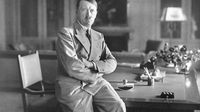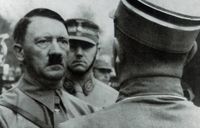Recently declassified documents from the U.S. Central Intelligence Agency (CIA) have revealed that American agents were actively searching for Adolf Hitler in South America for a decade after World War II. This revelation, reported by the New York Post, sheds light on the extent of the U.S. intelligence efforts to track down the Nazi leader, despite the widely accepted belief that he died in 1945.
On April 30, 1945, as Soviet troops advanced into Berlin, Hitler and his long-time companion Eva Braun, whom he had married just a day earlier, took their own lives in his underground bunker to evade capture. Their bodies were partially burned and buried in a shallow crater, and later exhumed by Soviet soldiers, who identified them using dental records.
Despite the official reports confirming Hitler's death, conspiracy theories soon emerged suggesting that he had survived the war and fled Germany via what were referred to as Nazi "rat lines". According to the declassified documents, U.S. field agents were skeptical of the official narrative and suspected that Hitler might have escaped to South America under a false identity.
One document from October 1945 indicated that U.S. military intelligence had informed the FBI about a potential secret refuge for Hitler at a spa hotel in La Falda, Argentina. The hotel owner and her family were described as "ardent supporters of Adolf Hitler," having made financial contributions to the Nazi Party through Joseph Goebbels in its early years. They had allegedly made preparations for Hitler to hide there if he needed a "safe haven." This raises questions about the extent of Nazi sympathies in South America and the potential for Hitler to have found refuge there.
Further investigations led to a CIA agent reporting in October 1955 that he had received information from a friend who spoke to a man claiming to be a former SS soldier named Phillip Citroen. Citroen asserted that Hitler was still alive and residing in Colombia. He claimed to have met with the former Nazi leader monthly and even produced a photograph that allegedly showed him with Hitler on a beach in Tunja, Colombia.
The man Citroen referred to was said to be named "Adolf Schüttelmayor." According to Citroen, Schüttelmayor had traveled from Colombia to Argentina in January 1955. American agents attempted to locate Schüttelmayor, but their efforts proved fruitless.
While there is no concrete evidence that Hitler survived the war, the documents highlight that many Nazis successfully fled to Argentina and other South American countries to avoid prosecution for their war crimes. The revelation of these documents has sparked renewed interest in the post-war escape routes used by Nazi officials and the role of American intelligence in aiding their evasion of justice.
In addition to the revelations about Hitler, the declassified documents come at a time when Argentina plans to unveil more information regarding the tens of thousands of Nazis who fled to the country after World War II. This move could further illuminate the historical connections between Nazi war criminals and South America.
These findings not only deepen our understanding of the immediate aftermath of World War II but also challenge the narrative surrounding Hitler's fate. The persistence of the search for Hitler underscores the complexities of post-war intelligence operations and the lingering questions about the extent of Nazi influence in South America.
As the world reflects on the consequences of World War II, these documents serve as a reminder of the ongoing mysteries surrounding one of history's most notorious figures. The hunt for Hitler may have ended, but the implications of his potential survival and the network that supported it continue to resonate.
In light of these revelations, historians and researchers are likely to delve deeper into the connections between Nazi officials and South America, as well as the role of intelligence agencies in facilitating their escape. The story of Hitler's alleged survival, whether fact or fiction, remains a captivating chapter in the annals of history.






